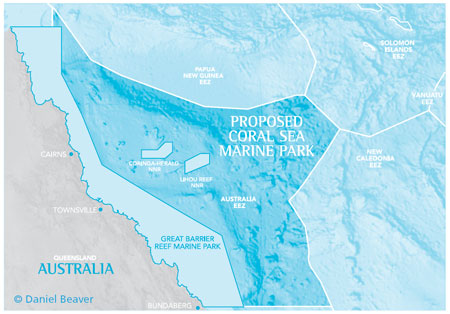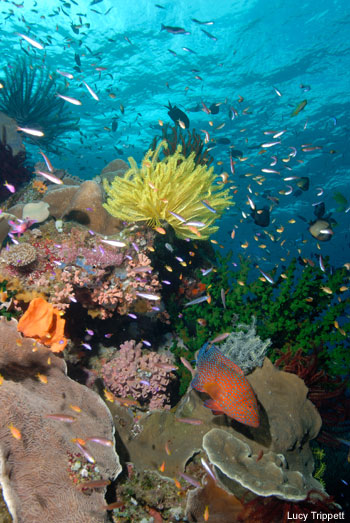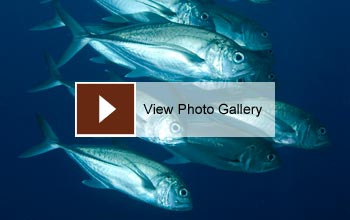Australia's Coral Sea
 Oceans cover almost three-quarters of the Earth's surface and contain most of the planet's biodiversity. Yet for all their richness, the oceans are in deep trouble. Scientists estimate that up to ninety percent of the largest fish species have been lost over the past 50 years due to overfishing. Roughly two-thirds of the world's coral reefs are damaged or threatened, and about a quarter have been destroyed. Yet less than 1 percent of the world's oceans are highly protected in marine parks.
Oceans cover almost three-quarters of the Earth's surface and contain most of the planet's biodiversity. Yet for all their richness, the oceans are in deep trouble. Scientists estimate that up to ninety percent of the largest fish species have been lost over the past 50 years due to overfishing. Roughly two-thirds of the world's coral reefs are damaged or threatened, and about a quarter have been destroyed. Yet less than 1 percent of the world's oceans are highly protected in marine parks.
Protecting the last remaining special places—before it is too late—is critical. Just as national parks conserve our lands, marine parks can help ensure ocean health for generations to come.
Australia's Coral Sea is one of the last places on Earth where ocean giants—sharks, tunas, marlin—still abound. Yet less than 1 percent of the Coral Sea is permanently protected from fishing, oil and gas exploration and seabed mining.
The Coral Sea may be the world's last great tropical ocean ecosystem where a permanent marine park—on the scale of the interim Coral Sea Conservation Zone, extending 972,000 square kilometres—could be established and effectively managed.
Protection of this special and important part of Australia would provide a safe haven for its marine life and a globally significant ocean legacy for generations to come.
Spectacular Marine Life
The Coral Sea is a global ‘biodiversity hot spot' because of the number and diversity of large ocean predators—sharks, tunas, marlin, swordfish and sailfish—found in its waters. It also contains:
|
An Australian Coral Sea Heritage Park - Natural History from Protect Our Coral Sea on Vimeo. |
- 52 species of deepwater sharks and rays, 18 of which are unique to the Coral Sea.
- At least 28 species of whales and dolphins, some found in pods up to 400 strong.
- The only known spawning aggregation of black marlin in the world.
- One of only three known spawning aggregations of deep-sea lanternfish in Australian waters, which attract large feeding schools of tunas, billfish and whale sharks.
- Abundant soft corals and large sea fans in the ocean's twilight zone (30 to 100 metres deep)
- Cold-water corals living on deep-sea knolls rising 200 to 300 metres from the seafloor.
- Spectacular sponge gardens, including ancient species considered “living fossils.”
- All species of eels that live in the freshwater streams of eastern Australia and New Zealand; these eels spawn in the northern Coral Sea and then embark on migrations of up to 3,000 kilometres.
Life on the Tropical Islands and Cays
- Endangered green turtles from as far away as the Torres Strait and Papua New Guinea nest on Coral Sea islands and cays.
- 36 species of seabirds are known to nest and feed in the Coral Sea
- 15 percent of Australia's Pisonia grandis forests (a species of flowering tree in the bougainvillea family) are found on the small islands and cays.
Threatened Species
341 bird and animal species in the Coral Sea are included on the International Union for Conservation of Nature Red List of Threatened Species. Of these, five Red List species are taken commercially in the Coral Sea:
- The humphead or Maori wrasse: endangered.
- Bigeye tuna: vulnerable.
- Yellowfin tuna, albacore tuna and striped marlin: near threatened.
- 62 threatened and protected species listed under Australia's Environment Protection and Biodiversity Conservation Act 1999 are known to exist in the Coral Sea.
A Landscape of Great Diversity
 The seafloor of the Coral Sea is amazingly diverse ranging from the northern end of a chain of submarine volcanoes, many encrusted by corals at their tip, to canyons deeper than 3 kilometres – one scoured out by a massive landslide off the Queensland continental slope. Other features include:
The seafloor of the Coral Sea is amazingly diverse ranging from the northern end of a chain of submarine volcanoes, many encrusted by corals at their tip, to canyons deeper than 3 kilometres – one scoured out by a massive landslide off the Queensland continental slope. Other features include:
- 18 spectacular coral reef systems, many with multiple small reefs.
- 3 huge plateaux, including the largest in the world – the Queensland Plateau, which contains the largest continental plateau reefs in the world.
- 2 wide trenches 1 to 2 kilometres deep, and one vast plain more than 4 kilometres deep.
The Coral Sea Ecosystem
The Coral Sea serves as a system of ‘stepping-stones' for the dispersal of species from the western Pacific to the Great Barrier Reef.
- It is an important migratory route for many species, such as sea turtles and oceanic sharks, riding the great ocean currents from the north.
- The East Australian Current forms in the Coral Sea and carries warm water and tropical species southward.
- The Coral Sea is ecologically fragile. The reefs are small, isolated from each other and exposed to severe weather.
For further information, read Australia's Coral Sea: A Biophysical Biological Profile, by Dr. Daniela Ceccarelli.







